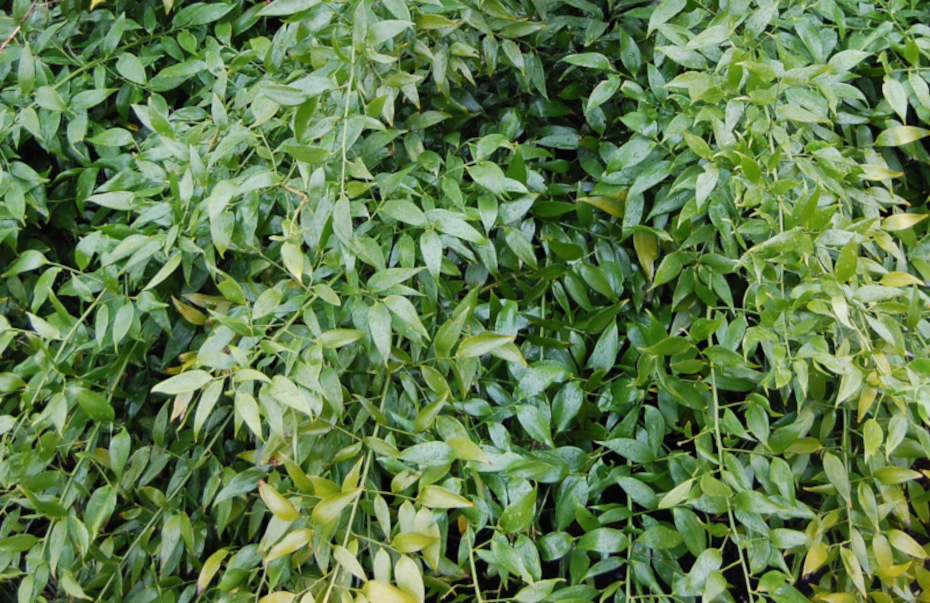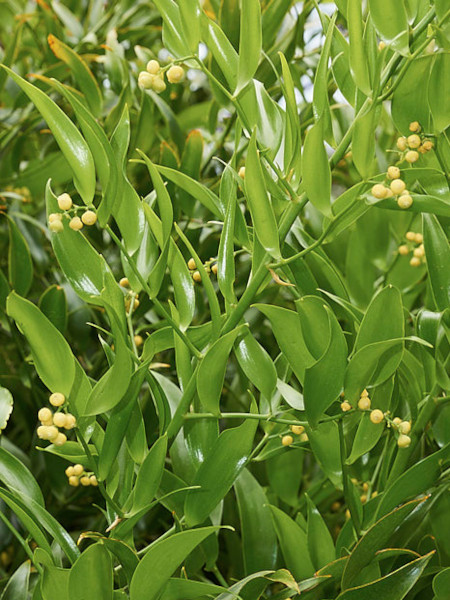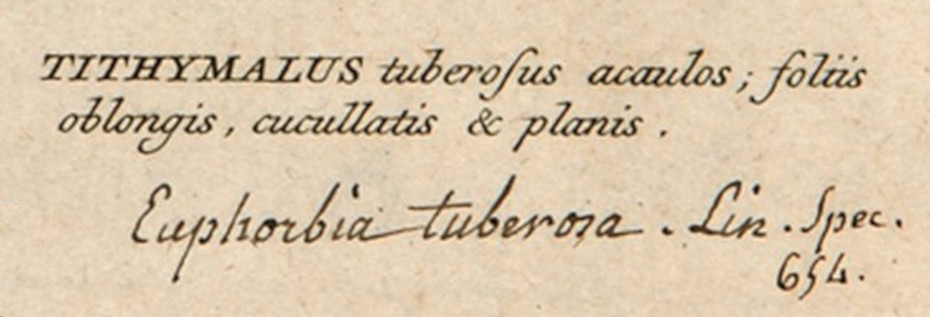This is a continuation from It’s all Latin to me (part 1) – Why on earth do we use Latin to name plants in Botany?
Like any language or notation that is unfamiliar, Botanical notations can be confusing and obscure, but they are a means of communication, not an esoteric puzzle. In this explanation of conventions used in Botany, you may come to find them of interest or use. I personally seek them out (usually in published papers but sometimes on the Internet as well) because the are so helpful to my understanding of the plant in question.

Let’s start with the above plant:
Danaë racemosa (L.) Moench in Methodus: 170 (1794)
Yes – I saw you roll your eyes!! Its not as bad as it looks – bear with me. So, Danaë racemosa you probably guessed are the genus & species of this item (I wrote about this plant in another post, if you are curious). But what does all that other stuff mean?
Danaë racemosa (L.) Moench in Methodus: 170 (1794)
In the highlighted portion above, the botanist(s) who made this classification is mentioned. For simplicity, the main botanist’s name is abbreviated in a standard recorded manner, in this case, Conrad Moench (1744-1805) – he was easy enough to Google. The ‘(L.)’ before Moench’s name represents Linnaeus (discussed in part 1 of this series), whose classification Moench was changing – the scientific process in action!
Danaë racemosa (L.) Moench in Methodus: 170 (1794)
This last highlighted part of the notation tell us in which of Moench’s publication this reclassification was published – Methodus plantas horti botanici et agri Marburgensis : a staminum situ describendi, 1794 (another fairly easy ‘Google’). In this way others would have access to his reasons for the reclassification. Not too hard now, right?

In some resources, you might find additional classifications clustered around the above:
Danaë racemosa (L.) Moench in Methodus: 170 (1794)
Synonyms
Ruscus racemosus L. in Sp. Pl.: 1041 (1753)
Danaë laurus Medik. in Malvenfam.: 72 (1787)
Ruscus terminalis Salisb. in Prodr. Stirp. Chap. Allerton: 255 (1796)
Danaidia racemosa (L.) Link in Handbuch 1: 274 (1829)
I have highlighted the original classification by Linnaeus (‘L.’) of this plant as Ruscus racemosus, in his famous Species Plantarum, published in 1753. It is now listed as a ‘synonym’ of Moench’s classification.
Also listed are other published classifications (which I ordered by publication date) that were ultimately not acknowledged or supported by the current scientific community (Ouch!). There are lots of reason why this might happen – especially in the past, publications take time to circulate to the broad community, so some botanists may even be unaware that a classification has already been made. Or they might have a different approach to that classification.
I was attending a lunch-time lecture at the University of California, Berkeley, Herbarium a few years back. Several of the staff botanists were chatting together when one asked another, “How is that species classification going? Are you still planning to name it for your wife?” The other answered, “It continues to be controversial. And it would be very problematic if <wife’s name> was reduced to synonymity!”



As mentioned above, I grow Danaë racemosa and can see how it is similar to various Ruscus species (which I have also grown). But I can also see, as did Moench apparently, how it is distinctly different from that group. Initially, plants were classified based on observed characteristics. As other eyes observed a plant, and the science progressed, so did our understanding, which lead to changes in the classification. Gardeners tend to be frustrated such name changes, which can seem to be random, but I always remind them they represent that something new has been learned.
Latin species names are assigned for various reasons that have little to do with how a gardener would perceive them. The New Zealand shrub Coprosma repens, which is common in gardens, is a good example. The specific epithet ‘repens‘ means “creeping” so I have often been asked why this typically upright shrub (even tall in some forms) was given this epithet? As I understand it, this species can be variable and at its native coasts, it can grown quite prostrate.
The Latin Binomial system is not meant to be fully descriptive of a given plant nor, as just shown, to represent its quintessential characteristic. Botanists consider attributes which help them differentiate between closely related species, but these may not be noticeable or important to gardeners.
Coprosma acerosa, which was classified a few years earlier, was certainly very deserving of being named ‘repens‘, but the botanist in that case chose acerosa which means “full of chaff”. Interestingly, Coprosma repens and C. acerosa produce a naturally occuring hybrid in New Zealand that has been named C. ×kirkii, which is also a very useful (and in this case fully creeping) plant in gardens.



Coprosma ×kirkii (Cheeseman) Cockayne, Veg. N.Z. 97 (1928)
Hybrid of Coprosma acerosa A.Cunn. × Coprosma repens sensu Hook.f.
Synonym
Coprosma kirkii Cheeseman, Trans. & Proc. NZ Inst. 29: 391 (1896 [1897])
Notice how the only change in the two Binomials above is the “×” in front of kirkii. You likely guessed that this denotes that it is a hybrid. What is interesting is that Thomas Cheeseman (1845-1923) didn’t realized that it was a hybrid when he classified it in 1896. In 1928, Leonard Cockayne (1855-1934)’s research uncovered this fact, so he added the “×”. This illustrates an important point that the science of Botany, like other sciences, is built upon what is known to date then adding new knowledge.
It also shows that plants, unlike animals, can often cross with each other and produce viable offspring. Sometimes such offspring are sterile, but not always. And that life on our planet pays little attention to how we classify it, ignoring what we might consider to be the rules!!
With the advance of computing powers, DNA sequencing of various life forms has exploded! The use of (chloroplast*) DNA to suggest lineage between separate life forms has also become a new are of research.
(*Chloroplast DNA is passed along intact from the seed parent, not as the recombined female and male DNA, providing a way of tracking relationships.)
Independent studies have built various ‘branches’ of life and these are now being pieced together. There have been confirmation of previously perceived relationships using this new approach, but there have also been many surprises.
For example, the well known Mediterranean rosemary has recently had a controversial identity shift!!
Salvia rosmarinus Spenn. in Handb.Angew.Bot. (1835)
Synonyms
Rosmarinus officinalis L. in Sp.Pl. (1753)
Rosmarinus angustifolius Mill. in Gard.Dict. (1768)
Rosmarinus flexuosus Jord.&Fourr. in Brev.Pl.Nov. (1866)
Rosmarinus rigidus Jord.&Fourr. in Brev.Pl.Nov. (1866)
Rosmarinus tenuifolius Jord.&Fourr. in Brev.Pl.Nov. (1866)
Rosmarinus ligusticus Gand. in Scrin.Fl.Select. (1883)
Salvia fasciculata Fernald in Proc.Amer.Acad.Arts (1905)
From what I understand, recent genetic research has placed Rosmarinus officinalis inside the phylogenetic table of Salvia. Since there had been a publication of R. officinalis as Salvia rosmarinus in 1835 by Spenn., according to the rules, the ‘Salvia’ name reverts to this earlier published name.

with S. rosmarinus (formerly Rosmarinus officinalis) highlighted.
Had this not been the case, the new name might have been S. officinalis, but we all know that was already legitimately taken (the culinary Sage plant), which is included in the above phylogenetic table excerpt.
This phylogenetic approach to classification is still new so things may continue to change. The genus Salvia is unique in being so very large, which was apparently part of the decision making process in this recent change – what would satisfy research and understanding but have the least disruption. Splitting up the genus and changing the names of large numbers of Salvia species was seen as more disruptive than bringing a few more species into the genus.

Perhaps they could have also considered how many non-botanists would be disrupted by changing the name of the well known and much loved culinary and aromatic herb rosemary!
We chanced to watch a silly episode of the ‘Sister Boniface Mysteries’ on PBS recently. My wife and I had previously noted the attention to ‘period’ detail (it is set in the 1960s, and we were there!). But I had to chuckle when the sister was walking through the garden of a suspected ‘white witch’, identifying plants (some poisonous) and she said “… and that’s Salvia rosmarinus, which is Rosemary to you and me”. Why don’t they ever hire a consulting botanist!!

Continued in It’s all Latin to me (part 3) – People are always correcting my Latin name pronunciation, what’s that about?
References and Links
(* Information retrieval date for the URL mentioned)
Methodus plantas horti botanici et agri Marburgensis : a staminum situ describendi. Bidiversity Heritage Library.
https://www.biodiversitylibrary.org/bibliography/304 (*September 2023)
Ribosomal DNA: Molecular Evolution and Phylogenetic Inference. The Quarterly Review of Biology. Vol 66, No 4, December 1991.
https://www.journals.uchicago.edu/doi/10.1086/417338 (*September 2023)
The chloroplast genome of Salvia : genomic characterization and phylogenetic analysis. International Journal of Plant Sciences. 181(8):812-830, May 2020
https://www.researchgate.net/figure/Phylogenetic-relationships-of-Salvia-based-on-the-data-set-of-complete-plastid-genome_fig5_341386838 (* September 2023)
Biota of New Zealand. Coprosma ×kirkii (Cheeseman) Cockayne. June 2022
https://biotanz.landcareresearch.co.nz/scientific-names/7eb5971b-b48f-44da-a420-3197bce1a1b0 (*October 2023)
